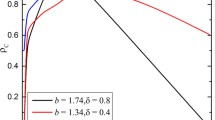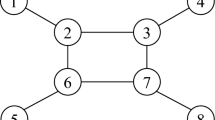Abstract
As the driving force of the evolutionary game, the strategy update mechanism is crucial to the evolution of cooperative behavior. At present, there has been a lot of research on the update mechanism, which mainly involves two aspects. On one hand, all players in the network use the same rule to update strategies; on the other hand, players use heterogeneous update rules, such as imitate and innovate. A sophisticated update mechanism is available. However, most of these studies are based on node dynamics, that is, individuals adopt the same strategy to their neighbors at the same time. Considering that in real life, faced with complex social relationships, the code of conduct generally followed by individuals is to adopt different decision-making behaviors for different opponents. Therefore, here, we are based on edge dynamics, which allows each player to adopt different strategies for different opponents. We analyze how the mixing ratio of the two mechanisms in the network affects the evolution of cooperative behavior based on imitation and myopic. The parameter u is introduced to represent the proportion of myopic players. The simulation results show that in the edge dynamics behavior patterns, compared with the myopic rule, the imitate rule plays a leading role in promoting the group to achieve a high level of cooperation, even when the temptation to defect is relatively large. Furthermore, for players who adopt the imitate update mechanism, individuals with high cooperation rate dominate when u is relatively high, and individuals with low cooperation rate dominate when u is relatively large. For players who adopt the myopic update rule, regardless of the value of u, the individual’s cooperation rate is 0.25 and 0.5 is dominant.
Graphic abstract








Similar content being viewed by others
Data Availability Statement
This manuscript has no associated data or the data will not be deposited. [Authors’ comment: The data can be generated by the program which implements the model, while the details of the model are already provided.]
References
K. Sigmund, The calculus of selfishness (Princeton University Press, Princeton, 2016)
M. Perc, J.J. Jordan, D.G. Rand et al., Statistical physics of human cooperation. Phys. Rep. 687, 1–51 (2017)
C. Gao, J. Liu, Network-based modeling for characterizing human collective behaviors during extreme events. IEEE Trans. Syst. Man Cybern. Syst. 47(1), 171–183 (2017)
C.P. Roca, J.A. Cuesta, A. Sánchez, Evolutionary game theory: temporal and spatial effects beyond replicator dynamics. Phys. Life Rev. 6(4), 208–249 (2009)
Y. Han, Z. Song, J. Sun et al., Investing the effect of age and cooperation in spatial multigame. Phys. A 541, 123269 (2020)
M.A. Nowak, R.M. May, Evolutionary games and spatial chaos. Nature 359(6398), 826–829 (1992)
D. Vilone, V. Capraro, J.J. Ramasco, Hierarchical invasion of cooperation in complex networks. J. Phys. Commun. 2(2), 025019 (2018)
M.G. Zimmermann, V.M. Eguíluz, Cooperation, social networks, and the emergence of leadership in a prisoner’s dilemma with adaptive local interactions. Phys. Rev. E 72(5), 056118 (2005)
G. Szabó, J. Vukov, A. Szolnoki, Phase diagrams for an evolutionary prisoner’s dilemma game on two-dimensional lattices. Phys. Rev. E 72(4), 047107 (2005)
J.M. Pacheco, A. Traulsen, H. Ohtsuki et al., Repeated games and direct reciprocity under active linking. J. Theor. Biol. 250(4), 723–731 (2008)
P. Zhu, X. Wang, D. Jia et al., Investigating the co-evolution of node reputation and edge-strategy in prisoner’s dilemma game. Appl. Math. Comput. 386, 125474 (2020)
Z. Wang, M. Jusup, L. Shi et al., Exploiting a cognitive bias promotes cooperation in social dilemma experiments. Nat. Commun. 9(1), 1–7 (2018)
A. Szolnoki, M. Perc, Vortices determine the dynamics of biodiversity in cyclical interactions with protection spillovers. New J. Phys. 17(11), 113033 (2015)
J. Shi, D. Hu, R. Tao et al., Interaction between populations promotes cooperation in voluntary prisoner’s dilemma. Appl. Math. Comput. 392, 125728 (2021)
C. Chu, X. Hu, C. Shen et al., Self-organized interdependence among populations promotes cooperation by means of coevolution. Chaos 29(1), 013139 (2019)
C. Vertebrates, Breeding together: kin selection and mutualism in. Science 296, 69 (2002)
M.A. Nowak, Five rules for the evolution of cooperation. Science 314(5805), 1560–1563 (2006)
S.A. West, A.S. Griffin, A. Gardner, Social semantics: altruism, cooperation, mutualism, strong reciprocity and group selection. J. Evol. Biol. 20(2), 415–432 (2007)
M.A. Nowak, K. Sigmund, Evolution of indirect reciprocity by image scoring. Nature 393(6685), 573–577 (1998)
Y. Jiao, T. Chen, Q. Chen, The impact of expressing willingness to cooperate on cooperation in public goods game. Chaos Solitons Fractals 140, 110258 (2020)
A. Szolnoki, M. ž Perc, G. Szabó, H.-U. Stark, Impact of aging on the evolution of cooperation in the spatial prisoner’s dilemma game. Phys. Rev. E 80, 021901 (2009)
W. Lu, J. Wang, C. Xia, Role of memory effect in the evolution of cooperation based on spatial prisoner’s dilemma game. Phys. Lett. A 382(42–43), 3058–3063 (2018)
M. Perc, A. Szolnoki, Coevolutionary games—a mini review. BioSystems 99, 109–125 (2010)
G. Cimini, A. Sánchez, Learning dynamics explains human behaviour in Prisoner’s dilemma on networks. J. R. Soc. Interface 11(94), 20131186 (2014)
A. Szolnoki, G. Szabó, Cooperation enhanced by inhomogeneous activity of teaching for evolutionary Prisoner’s dilemma games. EPL (Europhysics Letters) 77(3), 30004 (2007)
M. Sysi-Aho, J. SaramäKi, J. Kertész et al., Spatial snowdrift game with myopic agents. Eur. Phys. J. B 44(1), 129–135 (2005)
M.A. Nowak, R.M. May, Evolutionary games and spatial chaos. Nature 359, 826–829 (1992)
C. Gao, C. Liu, D. Schenz, X. Li, Z. Zhang, M. Jusup, Z. Wang, M. Beekman, T. Nakagaki, Does being multi-headed make you better at solving problems? A survey of physarum-based models and computations. Phys. Life Rev. 29, 1–26 (2019)
M. Perc, A. Szolnoki, Social diversity and promotion of cooperation in the spatial prisoner’s dilemma game. Phys. Rev. E 77, 011904 (2008)
A. Szolnoki, X. Chen, Gradual learning supports cooperation in spatial prisoner’s dilemma game. Chaos Solitons Fractals 130, 109447 (2020)
A. Szolnoki, M. Perc, Leaders should not be conformists in evolutionary social dilemmas. Sci. Rep. 6, 23633 (2016)
A. Szolnoki, X. Chen, Competition and partnership between conformity and payoff-based imitations in social dilemmas. New J. Phys. 20(9), 093008 (2018)
P. Zhu, X. Hou, Y. Guo et al., Investigating the effects of updating rules on cooperation by incorporating interactive diversity. Eur. Phys. J. B 94(2), 58 (2021)
Z. Danku, Z. Wang, A. Szolnoki, Imitate or innovate: competition of strategy updating attitudes in spatial social dilemma games. EPL 121, 18002 (2018)
A. Szolnoki, Z. Danku, Dynamic-sensitive cooperation in the presence of multiple strategy updating rules. Phys. A 511, 371–377 (2018)
M.A. Amaral, M.A. Javarone, Heterogeneous update mechanisms in evolutionary games: mixing innovative and imitative dynamics. Phys. Rev. E 97, 042305 (2018)
J. Vukov, G. Szabó, A. Szolnoki, Cooperation in the noisy case: prisoner’s dilemma game on two types of regular random graphs. Phys. Rev. E 73(6), 067103 (2006)
Q. Su, A. Li, L. Zhou, L. Wang, Interactive diversity promotes the evolution of cooperation in structured populations. New J. Phys. 18, 103007 (2016)
Q. Su, A. Li, L. Wang, Evolutionary dynamics under interactive diversity. New J. Phys. 19, 103023 (2017)
M. Perc, A. Szolnoki, G. Szab’o, Restricted connections among distinguished players support cooperation. Phys. Rev. E 78, 066101 (2008)
A. Szolnoki, M. Perc, Promoting cooperation in social dilemmas via simple coevolutionary rules. Eur. Phys. J. B 67, 337–344 (2009)
Acknowledgements
This work was supported in part by National Key R&D Program of China (Grant no. 2018AAA0100905), National Natural Science Foundation of China (Grant No. 62073263), and Key Technology Research and Development Program of Science and Technology-Scientific and Technological Innovation Team of Shaanxi Province (Grant No. 2020TD-013).
Author information
Authors and Affiliations
Corresponding author
Rights and permissions
About this article
Cite this article
Li, X., Cheng, L., Niu, X. et al. Highly cooperative individuals’ clustering property in myopic strategy groups. Eur. Phys. J. B 94, 126 (2021). https://doi.org/10.1140/epjb/s10051-021-00136-5
Received:
Accepted:
Published:
DOI: https://doi.org/10.1140/epjb/s10051-021-00136-5




